201771010126 王燕《面向对象程序设计(java)》第八周学习总结
实验六 接口的定义与使用
实验时间 2018-10-18
1、实验目的与要求
(1) 掌握接口定义方法
JAVA中通过interface关键字定义接口;
接口中只能定义public static final(也可以在定义时不写,系统是默认的)修饰的变量以及抽象方法
接口中定义的变量必须有初始值
(2) 掌握实现接口类的定义要求;
接口体中包含常量定义和方法定义,接口中只进行方法的声明,不提供方法的实现;且接口中的任何方法都自动是public,字段也总是public static final的。
(3) 掌握实现了接口类的使用要求;
接口不能构造接口对象,但可以声明接口变量以指向一个实现了该接口的类的对象。
可以用instanceof来检查对象是否实现了某个接口。
通常接口的名字以able或ible结尾;
可以使用extends来继承接口的常量和抽象方法,扩展形成新的接口;
接口中的所有常量必须是public static final,方法必须是public abstract,这是系统默认的,不管你在定义接口时,写不写修饰符都是一样的。
在类声明时用implements关键字声明使用一个或多个接口
一个类使用了某个接口,那么这个类必须实现该接口的所有方法,即为这些方法提供方法体。
一个类可以实现多个接口,接口间应该用逗号分隔开。
若实现接口的类不是抽象类,则必须实现所有接口的所有方法,即为所有的抽象方法定义方法体。
一个类在实现某接口抽象方法时,必须使用完全相同的方法名,参数列表,返回值类型。
接口的抽象方法的访问控制符已指定为public,所以类在实现时,必须显示的使用public修饰符,否则被警告缩小了接口中定义的方法的访问控制范围。
区分重载与覆盖。
(4) 掌握程序回调设计模式;
回调(callback)是一种常见的程序设计模式,在这种模式中,可以指出某个特定事件发生时应该采取的动作。
在java.swing包中有一个Timer类,可以使用它在到达给定的时间间隔是触发一个事件
(5) 掌握Comparator接口用法;
(6) 掌握对象浅层拷贝与深层拷贝方法;
浅层拷贝: 被拷贝的对象的所有成员属性都有与原来的对象相同的值,而所有的对其他对象的引用仍然指向原来的对象。换言之,浅层拷贝仅仅拷贝所考虑的对象,而不拷贝它所引用的对象。(概念不好理解,请结合下文的示例去理解)
深层拷贝:被拷贝对象的所有变量都含有与原来的对象相同的值,除去那些引用其他对象的变量。那些引用其他对象的变量将指向被复制过的新对象,而不是原有的那些被引用的对象。换言之,深层拷贝要拷贝的对象引用的对象都拷贝一遍
(7) 掌握Lambda表达式语法;
lambda表达式由如下几个部分组成:
在圆括号中以逗号分隔的形参列表。在CheckPerson.test方法中包含一个参数p,代表了一个Person类的实例。
(8) 了解内部类的用途及语法要求。
内部类(inner class)是定义在另一个类内部的类。
使用内部类的原因有以下三个:
内部类方法可以访问该类定义所在的作用域中的数据,包括私有数据。
内部类能够隐藏起来,不为同一包中的其他类所见。
想要定义一个回调函数且不想编写大量代码时,使用匿名内部类比较便捷。
内部类可以直接访问外部类的成员,包括private成员,但是内部类的成员却不能被外部类直接访问。
局部内部类
在内部类对象保存了一个对外部类对象的引用,当内部类的成员方法中访问某一变量时,如果在该方法和内部类中都没有定义过这个变量,内部类中对this的引用会被传递给那个外部类对象的引用。
内部类并非只能在类里定义,也可以在几个程序块的范围之内定义局部内部类。例如,在方法中,或甚至在for循环体内部,都可以定义内部类 。
局部内部类不能用public或private访问修饰符进行声明,它的作用域被限定在声明这个局部类的块中。
局部内部类不仅能够访问包含它们的外部类,还可以访问方法中的final类型的局部变量,用final定义的局部变量相当于是一个常量,它的生命周期超出方法运行的生命周期。
匿名内部类
将局部内部类的使用再深入一步,假如只创建这个类的一个对象,就不必命名,将这种类称为匿名内部类(anonymous inner class)。
由于构造器的名字必须与类名相同,而匿名类没有类名,所以匿名类不能有构造器,取而代之的是将构造器参数传递给超类的构造器。尤其是在内部类实现接口的时候,不能有任何构造参数。
如果构造参数的闭圆括号跟一个开花括号,正在定义的就是匿名内部类。
静态内部类
如果用static修饰一个内部类,这个类就相当于是一个外部定义的类,所以static的内部类中可声明static成员,但是,非static的内部类中的成员是不能声明为static的。static的内部类不能再使用外部类的非static的成员变量,这个道理不难想象!所以static内部类很少使用。
2、实验内容和步骤
实验1: 导入第6章示例程序,测试程序并进行代码注释。
测试程序1:
l 编辑、编译、调试运行阅读教材214页-215页程序6-1、6-2,理解程序并分析程序运行结果;
l 在程序中相关代码处添加新知识的注释。
l 掌握接口的实现用法;
l 掌握内置接口Compareable的用法
package interfaces; public class Employee implements Comparable<Employee>
{
private String name;
private double salary; public Employee(String name, double salary)
{
this.name = name;
this.salary = salary;
} public String getName()
{
return name;
} public double getSalary()
{
return salary;
} public void raiseSalary(double byPercent)
{
double raise = salary * byPercent / 100;
salary += raise;
} /**
* Compares employees by salary
* @param other another Employee object
* @return a negative value if this employee has a lower salary than
* otherObject, 0 if the salaries are the same, a positive value otherwise
*/
public int compareTo(Employee other)
{
return Double.compare(salary, other.salary);
}
}

package interfaces; import java.util.*; /**
* This program demonstrates the use of the Comparable interface.
* @version 1.30 2004-02-27
* @author Cay Horstmann
*/
public class EmployeeSortTest
{
public static void main(String[] args)
{
Employee[] staff = new Employee[3]; staff[0] = new Employee("Harry Hacker", 35000);
staff[1] = new Employee("Carl Cracker", 75000);
staff[2] = new Employee("Tony Tester", 38000); Arrays.sort(staff); // print out information about all Employee objects
for (Employee e : staff)
System.out.println("name=" + e.getName() + ",salary=" + e.getSalary());
}
}

测试程序2:
l 编辑、编译、调试以下程序,结合程序运行结果理解程序;
|
interface A { double g=9.8; void show( ); } class C implements A { public void show( ) {System.out.println("g="+g);} }
class InterfaceTest { public static void main(String[ ] args) { A a=new C( ); a.show( ); System.out.println("g="+C.g); } } |

测试程序3:
l 在elipse IDE中调试运行教材223页6-3,结合程序运行结果理解程序;
l 26行、36行代码参阅224页,详细内容涉及教材12章。
l 在程序中相关代码处添加新知识的注释。
l 掌握回调程序设计模式;
package timer; /**
@version 1.01 2015-05-12
@author Cay Horstmann
*/ import java.awt.*;
import java.awt.event.*;
import java.util.*;
import javax.swing.*;
import javax.swing.Timer;
// to resolve conflict with java.util.Timer public class TimerTest
{
public static void main(String[] args)
{
ActionListener listener = new TimePrinter(); // construct a timer that calls the listener
// once every 10 seconds
Timer t = new Timer(10000, listener);
t.start(); JOptionPane.showMessageDialog(null, "Quit program?");
System.exit(0);
}
} class TimePrinter implements ActionListener
{
public void actionPerformed(ActionEvent event)
{
System.out.println("At the tone, the time is " + new Date());
Toolkit.getDefaultToolkit().beep();
}
}
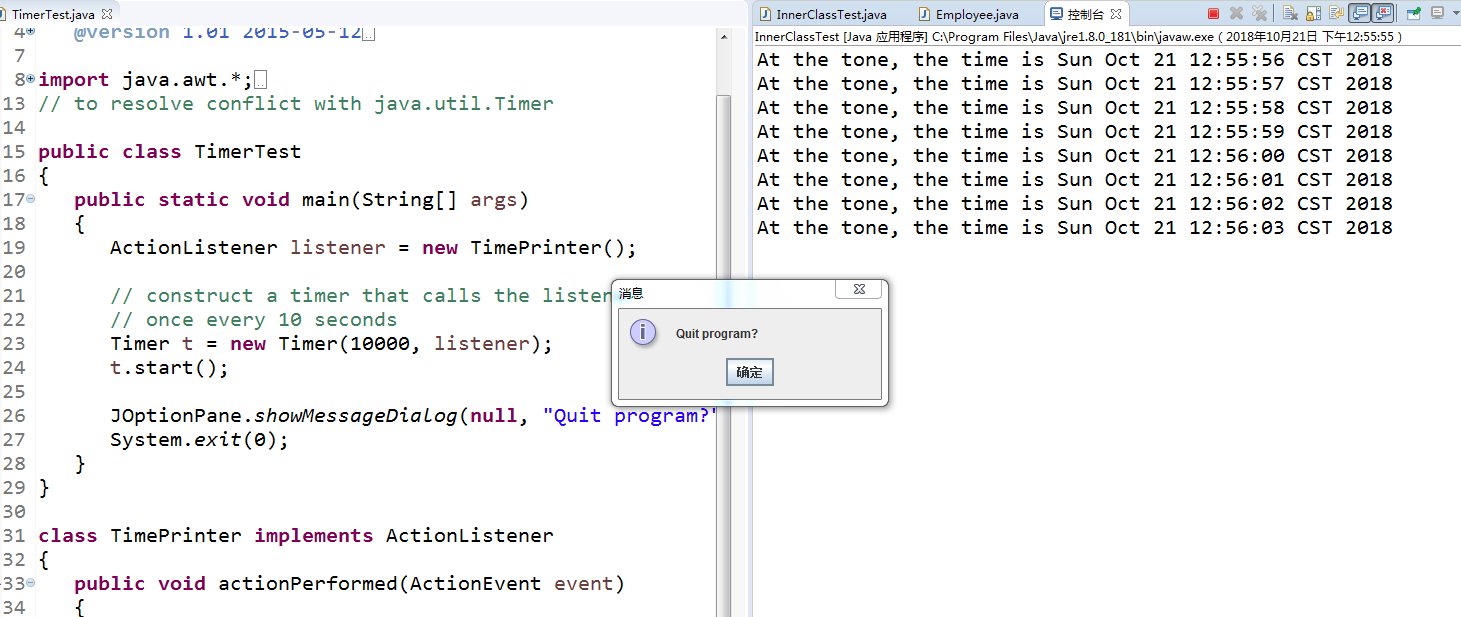
测试程序4:
l 调试运行教材229页-231页程序6-4、6-5,结合程序运行结果理解程序;
l 在程序中相关代码处添加新知识的注释。
l 掌握对象克隆实现技术;
l 掌握浅拷贝和深拷贝的差别。
package clone; import java.util.Date;
import java.util.GregorianCalendar; public class Employee implements Cloneable
{
private String name;
private double salary;
private Date hireDay; public Employee(String name, double salary)
{
this.name = name;
this.salary = salary;
hireDay = new Date();
} public Employee clone() throws CloneNotSupportedException
{
// call Object.clone()
Employee cloned = (Employee) super.clone(); // clone mutable fields
cloned.hireDay = (Date) hireDay.clone(); return cloned;
} /**
* Set the hire day to a given date.
* @param year the year of the hire day
* @param month the month of the hire day
* @param day the day of the hire day
*/
public void setHireDay(int year, int month, int day)
{
Date newHireDay = new GregorianCalendar(year, month - 1, day).getTime(); // Example of instance field mutation
hireDay.setTime(newHireDay.getTime());
} public void raiseSalary(double byPercent)
{
double raise = salary * byPercent / 100;
salary += raise;
} public String toString()
{
return "Employee[name=" + name + ",salary=" + salary + ",hireDay=" + hireDay + "]";
}
}

package clone; /**
* This program demonstrates cloning.
* @version 1.10 2002-07-01
* @author Cay Horstmann
*/
public class CloneTest
{
public static void main(String[] args)
{
try
{
Employee original = new Employee("John Q. Public", 50000);
original.setHireDay(2000, 1, 1);
Employee copy = original.clone();
copy.raiseSalary(10);
copy.setHireDay(2002, 12, 31);
System.out.println("original=" + original);
System.out.println("copy=" + copy);
}
catch (CloneNotSupportedException e)
{
e.printStackTrace();
}
}
}

实验2: 导入第6章示例程序6-6,学习Lambda表达式用法。
l 调试运行教材233页-234页程序6-6,结合程序运行结果理解程序;
l 在程序中相关代码处添加新知识的注释。
l 将27-29行代码与教材223页程序对比,将27-29行代码与此程序对比,体会Lambda表达式的优点。
package lambda; import java.util.*; import javax.swing.*;
import javax.swing.Timer; /**
* This program demonstrates the use of lambda expressions.
* @version 1.0 2015-05-12
* @author Cay Horstmann
*/
public class LambdaTest
{
public static void main(String[] args)
{
String[] planets = new String[] { "Mercury", "Venus", "Earth", "Mars",
"Jupiter", "Saturn", "Uranus", "Neptune" };
System.out.println(Arrays.toString(planets));
System.out.println("Sorted in dictionary order:");
Arrays.sort(planets);
System.out.println(Arrays.toString(planets));
System.out.println("Sorted by length:");
Arrays.sort(planets, (first, second) -> first.length() - second.length());
System.out.println(Arrays.toString(planets)); Timer t = new Timer(1000, event ->
System.out.println("The time is " + new Date()));
t.start(); // keep program running until user selects "Ok"
JOptionPane.showMessageDialog(null, "Quit program?");
System.exit(0);
}
}
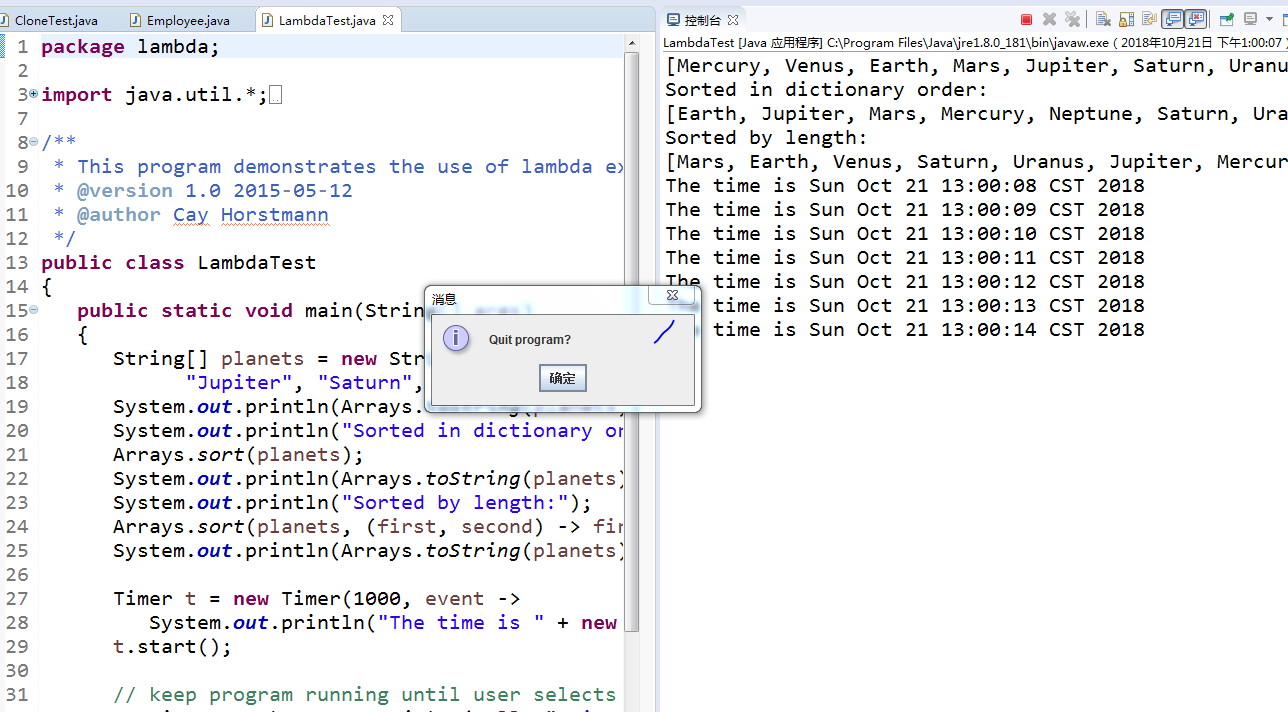
注:以下实验课后完成
实验3: 编程练习
l 编制一个程序,将身份证号.txt 中的信息读入到内存中;
l 按姓名字典序输出人员信息;
l 查询最大年龄的人员信息;
l 查询最小年龄人员信息;
l 输入你的年龄,查询身份证号.txt中年龄与你最近人的姓名、身份证号、年龄、性别和出生地;
l 查询人员中是否有你的同乡
import java.io.BufferedReader;
import java.io.File;
import java.io.FileInputStream;
import java.io.FileNotFoundException;
import java.io.IOException;
import java.io.InputStreamReader;
import java.util.ArrayList;
import java.util.Arrays;
import java.util.Collections;
import java.util.Scanner; public class Check{
private static ArrayList<Student> studentlist;
public static void main(String[] args) {
studentlist = new ArrayList<>();
Scanner scanner = new Scanner(System.in);
File file = new File("C:\\下载\\身份证号.txt");
try {
FileInputStream fis = new FileInputStream(file);
BufferedReader in = new BufferedReader(new InputStreamReader(fis));
String temp = null;
while ((temp = in.readLine()) != null) { Scanner linescanner = new Scanner(temp); linescanner.useDelimiter(" ");
String name = linescanner.next();
String number = linescanner.next();
String sex = linescanner.next();
String age = linescanner.next();
String province =linescanner.nextLine();
Student student = new Student();
student.setName(name);
student.setnumber(number);
student.setsex(sex);
int a = Integer.parseInt(age);
student.setage(a);
student.setprovince(province);
studentlist.add(student); }
} catch (FileNotFoundException e) {
System.out.println("学生信息文件找不到");
e.printStackTrace();
} catch (IOException e) {
System.out.println("学生信息文件读取错误");
e.printStackTrace();
}
boolean isTrue = true;
while (isTrue) {
System.out.println("选择你的操作,输入正确格式的选项");
System.out.println("1.按姓名字典序输出人员信息");
System.out.println("2.输出年龄最大和年龄最小的人");
System.out.println("3.查找老乡");
System.out.println("4.查找年龄相近的人");
System.out.println("5.退出");
String m = scanner.next();
switch (m) {
case "1":
Collections.sort(studentlist);
System.out.println(studentlist.toString());
break;
case "2":
int max=0,min=100;
int j,k1 = 0,k2=0;
for(int i=1;i<studentlist.size();i++)
{
j=studentlist.get(i).getage();
if(j>max)
{
max=j;
k1=i;
}
if(j<min)
{
min=j;
k2=i;
} }
System.out.println("年龄最大:"+studentlist.get(k1));
System.out.println("年龄最小:"+studentlist.get(k2));
break;
case "3":
System.out.println("输入省份");
String find = scanner.next();
String place=find.substring(0,3);
for (int i = 0; i <studentlist.size(); i++)
{
if(studentlist.get(i).getprovince().substring(1,4).equals(place))
System.out.println("老乡"+studentlist.get(i));
}
break; case "4":
System.out.println("年龄:");
int yourage = scanner.nextInt();
int near=agenear(yourage);
int value=yourage-studentlist.get(near).getage();
System.out.println(""+studentlist.get(near));
break;
case "5":
isTrue = false;
System.out.println("退出程序!");
break;
default:
System.out.println("输入有误"); }
}
}
public static int agenear(int age) {
int j=0,min=53,value=0,k=0;
for (int i = 0; i < studentlist.size(); i++)
{
value=studentlist.get(i).getage()-age;
if(value<0) value=-value;
if (value<min)
{
min=value;
k=i;
}
}
return k;
} }
public class Student implements Comparable<Student> {
private String name;
private String number ;
private String sex ;
private int age;
private String province;
public String getName() {
return name;
}
public void setName(String name) {
this.name = name;
}
public String getnumber() {
return number;
}
public void setnumber(String number) {
this.number = number;
}
public String getsex() {
return sex ;
}
public void setsex(String sex ) {
this.sex =sex ;
}
public int getage() {
return age;
}
public void setage(int age) {
// int a = Integer.parseInt(age);
this.age= age;
}
public String getprovince() {
return province;
}
public void setprovince(String province) {
this.province=province ;
}
public int compareTo(Student o) {
return this.name.compareTo(o.getName());
}
public String toString() {
return name+"\t"+sex+"\t"+age+"\t"+number+"\t"+province+"\n";
}
}


实验4:内部类语法验证实验
实验程序1:
l 编辑、调试运行教材246页-247页程序6-7,结合程序运行结果理解程序;
l 了解内部类的基本用法。
package innerClass; import java.awt.*;
import java.awt.event.*;
import java.util.*;
import javax.swing.*;
import javax.swing.Timer; /**
* This program demonstrates the use of inner classes.
* @version 1.11 2015-05-12
* @author Cay Horstmann
*/
public class InnerClassTest
{
public static void main(String[] args)
{
TalkingClock clock = new TalkingClock(1000, true);
clock.start(); // keep program running until user selects "Ok"
JOptionPane.showMessageDialog(null, "Quit program?");
System.exit(0);
}
} /**
* A clock that prints the time in regular intervals.
*/
class TalkingClock
{
private int interval;
private boolean beep; /**
* Constructs a talking clock
* @param interval the interval between messages (in milliseconds)
* @param beep true if the clock should beep
*/
public TalkingClock(int interval, boolean beep)
{
this.interval = interval;
this.beep = beep;
} /**
* Starts the clock.
*/
public void start()
{
ActionListener listener = new TimePrinter();
Timer t = new Timer(interval, listener);
t.start();
} public class TimePrinter implements ActionListener
{
public void actionPerformed(ActionEvent event)
{
System.out.println("At the tone, the time is " + new Date());
if (beep) Toolkit.getDefaultToolkit().beep();
}
}
}
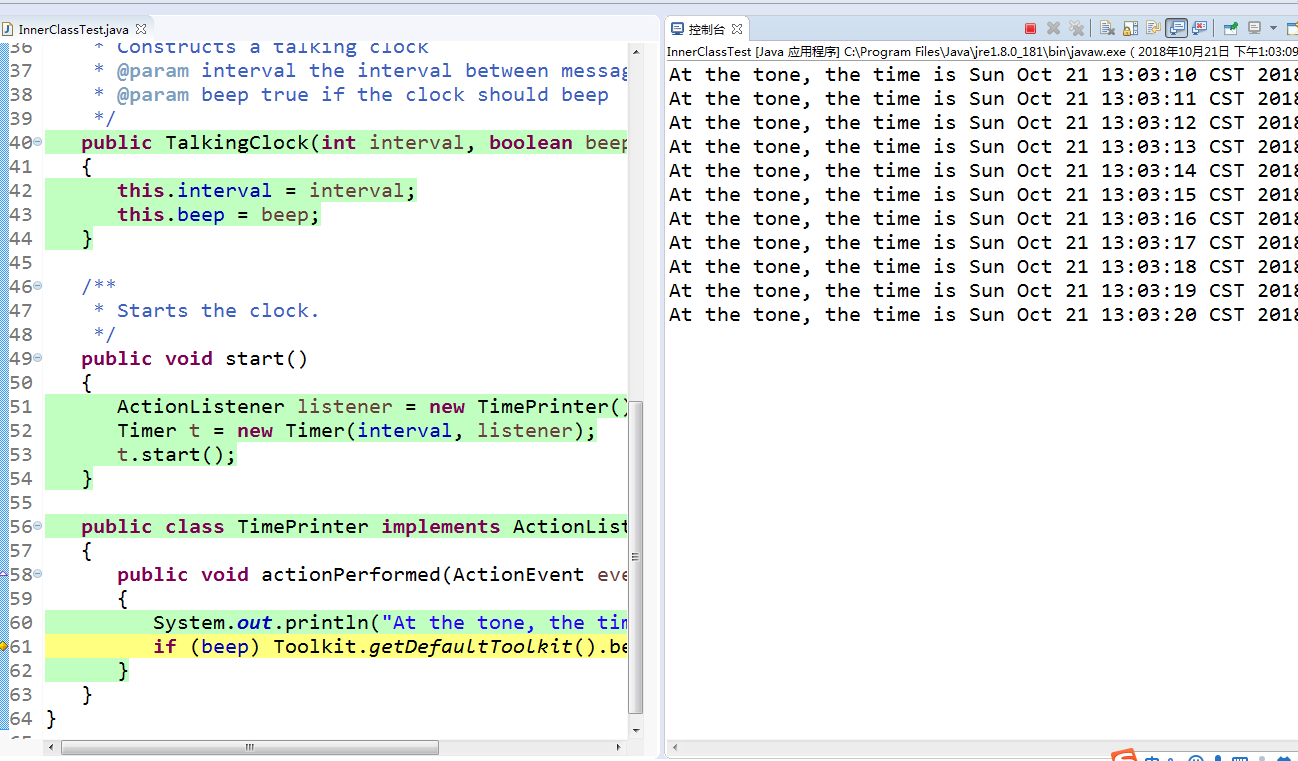
实验程序2:
l 编辑、调试运行教材254页程序6-8,结合程序运行结果理解程序;
l 了解匿名内部类的用法。
package anonymousInnerClass; import java.awt.*;
import java.awt.event.*;
import java.util.*;
import javax.swing.*;
import javax.swing.Timer; /**
* This program demonstrates anonymous inner classes.
* @version 1.11 2015-05-12
* @author Cay Horstmann
*/
public class AnonymousInnerClassTest
{
public static void main(String[] args)
{
TalkingClock clock = new TalkingClock();
clock.start(1000, true); // keep program running until user selects "Ok"
JOptionPane.showMessageDialog(null, "Quit program?");
System.exit(0);
}
} /**
* A clock that prints the time in regular intervals.
*/
class TalkingClock
{
/**
* Starts the clock.
* @param interval the interval between messages (in milliseconds)
* @param beep true if the clock should beep
*/
public void start(int interval, boolean beep)
{
ActionListener listener = new ActionListener()
{
public void actionPerformed(ActionEvent event)
{
System.out.println("At the tone, the time is " + new Date());
if (beep) Toolkit.getDefaultToolkit().beep();
}
};
Timer t = new Timer(interval, listener);
t.start();
}
}
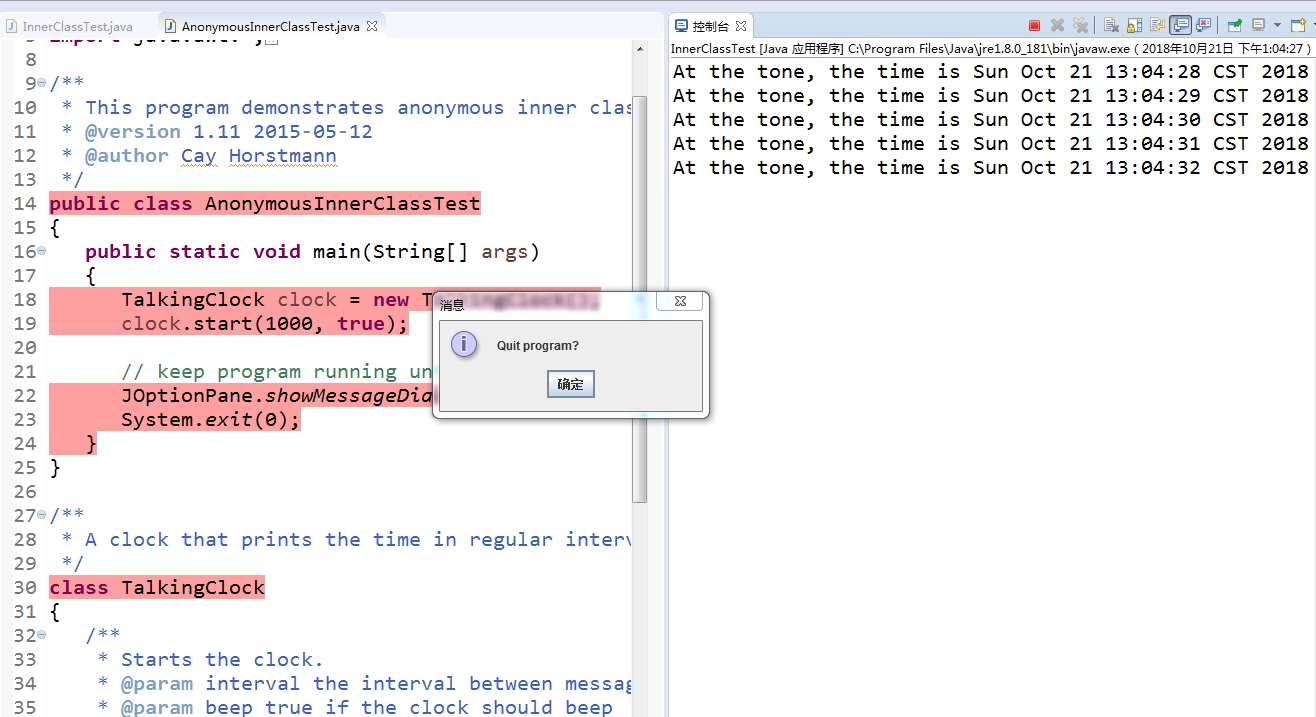
实验程序3:
l 在elipse IDE中调试运行教材257页-258页程序6-9,结合程序运行结果理解程序;
l 了解静态内部类的用法。
package staticInnerClass; /**
* This program demonstrates the use of static inner classes.
* @version 1.02 2015-05-12
* @author Cay Horstmann
*/
public class StaticInnerClassTest
{
public static void main(String[] args)
{
double[] d = new double[20];
for (int i = 0; i < d.length; i++)
d[i] = 100 * Math.random();
ArrayAlg.Pair p = ArrayAlg.minmax(d);
System.out.println("min = " + p.getFirst());
System.out.println("max = " + p.getSecond());
}
} class ArrayAlg
{
/**
* A pair of floating-point numbers
*/
public static class Pair
{
private double first;
private double second; /**
* Constructs a pair from two floating-point numbers
* @param f the first number
* @param s the second number
*/
public Pair(double f, double s)
{
first = f;
second = s;
} /**
* Returns the first number of the pair
* @return the first number
*/
public double getFirst()
{
return first;
} /**
* Returns the second number of the pair
* @return the second number
*/
public double getSecond()
{
return second;
}
} /**
* Computes both the minimum and the maximum of an array
* @param values an array of floating-point numbers
* @return a pair whose first element is the minimum and whose second element
* is the maximum
*/
public static Pair minmax(double[] values)
{
double min = Double.POSITIVE_INFINITY;
double max = Double.NEGATIVE_INFINITY;
for (double v : values)
{
if (min > v) min = v;
if (max < v) max = v;
}
return new Pair(min, max);
}
}
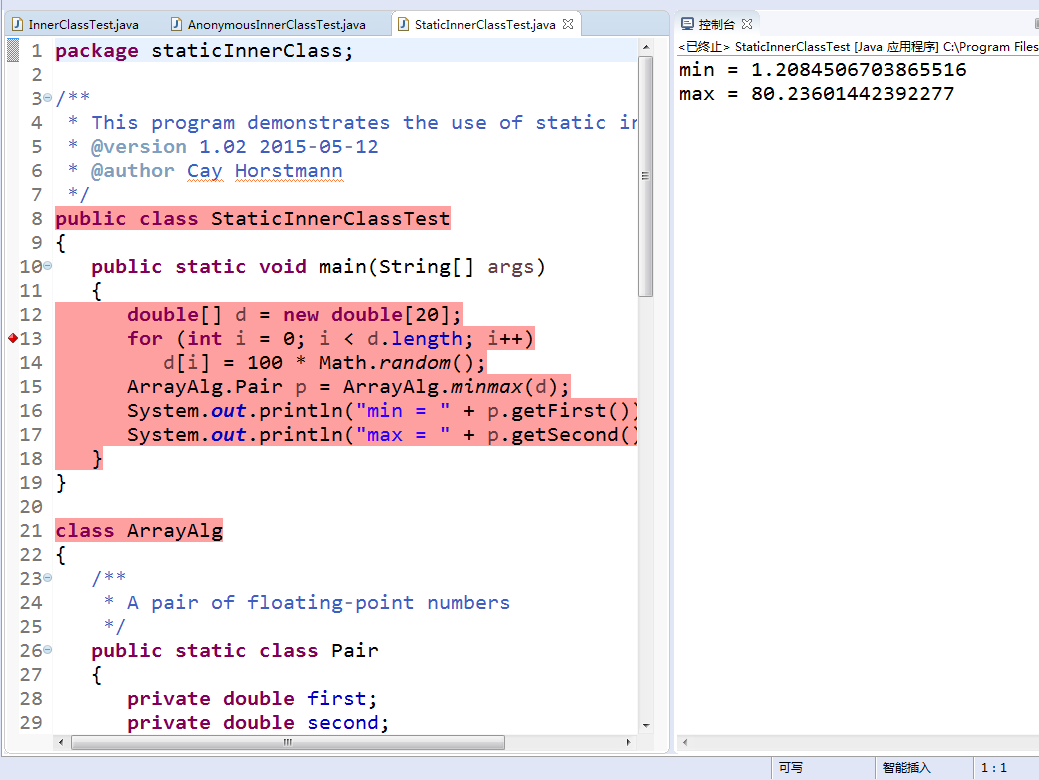
实验总结:
通过第六章的学习,明白了继承与接口实现的区别,两者最大的区别就是,类只能继承一个父类,一个类可以实现多个借口,类通过使用关键字implements声明自己实现一个或多个类,如果一个非抽象类实现了某个借口,那么这个非抽象类必须重写该接口的所有方法。使用clone的方法,可以有别于直接复制,可以对复制的内容重新定义方法等,通过对示例代码的测试,对第六章内容有了进一步的理解。
201771010126 王燕《面向对象程序设计(java)》第八周学习总结的更多相关文章
- 201771010134杨其菊《面向对象程序设计java》第九周学习总结
第九周学习总结 第一部分:理论知识 异常.断言和调试.日志 1.捕获 ...
- 201871010132-张潇潇《面向对象程序设计(java)》第一周学习总结
面向对象程序设计(Java) 博文正文开头 项目 内容 这个作业属于哪个课程 https://www.cnblogs.com/nwnu-daizh/ 这个作业的要求在哪里 https://www.cn ...
- 扎西平措 201571030332《面向对象程序设计 Java 》第一周学习总结
<面向对象程序设计(java)>第一周学习总结 正文开头: 项目 内容 这个作业属于哪个课程 https://www.cnblogs.com/nwnu-daizh/ 这个作业的要求在哪里 ...
- 201871010124 王生涛《面向对象程序设计JAVA》第一周学习总结
项目 内容 这个作业属于哪个课程 https://www.cnblogs.com/nwnu-daizh/ 这个作业的要求在哪里 https://edu.cnblogs.com/campus/xbsf/ ...
- 杨其菊201771010134《面向对象程序设计Java》第二周学习总结
第三章 Java基本程序设计结构 第一部分:(理论知识部分) 本章主要学习:基本内容:数据类型:变量:运算符:类型转换,字符串,输入输出,控制流程,大数值以及数组. 1.基本概念: 1)标识符:由字母 ...
- 201871010115——马北《面向对象程序设计JAVA》第二周学习总结
项目 内容 这个作业属于哪个课程 https://www.cnblogs.com/nwnu-daizh/ 这个作业的要求在哪里 https://www.cnblogs.com/nwnu-daizh/p ...
- 201777010217-金云馨《面向对象程序设计(Java)》第二周学习总结
项目 内容 这个作业属于哪个课程 https://www.cnblogs.com/nwnu-daizh/ 这个作业的要求在哪里 https://www.cnblogs.com/nwnu-daizh/p ...
- 201871010132——张潇潇《面向对象程序设计JAVA》第二周学习总结
项目 内容 这个作业属于哪个课程 https://www.cnblogs.com/nwnu-daizh/ 这个作业的要求在哪里 https://www.cnblogs.com/nwnu-daizh/p ...
- 201771010123汪慧和《面向对象程序设计Java》第二周学习总结
一.理论知识部分 1.标识符由字母.下划线.美元符号和数字组成, 且第一个符号不能为数字.标识符可用作: 类名.变量名.方法名.数组名.文件名等.第二部分:理论知识学习部分 2.关键字就是Java语言 ...
- 20155321 2016-2017-2 《Java程序设计》第八周学习总结
20155321 2016-2017-2 <Java程序设计>第八周学习总结 教材学习内容总结 创建Logger对象 static Logger getLogger(String name ...
随机推荐
- React 记录(4)
React文档:https://www.reactjscn.com/docs/components-and-props.html 慢慢学习:对照教程文档,逐句猜解,截图 React官网:https:/ ...
- 在 Visual Studio 中使用 IntelliTrace 快照功能
今天发现vs2017 IntelliTrace有了一个快照功能,测试一下它的用法 1.选项->IntelliTrace->选择第三项 2.建一个控制台应用程序 3.在main中写一个简单的 ...
- [物理学与PDEs]第1章第4节 电磁能量和电磁动量, 能量、动量守恒与转化定律 4.3 电磁能量 (动量) 密度, 电磁能量流 (动量流) 密度
1. 电磁能量密度: $\cfrac{1}{2}\sex{\ve_0E^2+\cfrac{1}{\mu_0}B^2}$. 2. 电磁能量流密度向量: ${\bf S}=\cfrac{1}{\mu_0} ...
- Educational Codeforces Round 55 (Rated for Div. 2)
D. Maximum Diameter Graph 题意 给出每个点的最大度,构造直径尽可能长的树 思路 让度数大于$1$的点构成链,考虑是否能在链的两端加度为$1$的点 代码 #include &l ...
- 迅为iTOP-4418/6818开发板-驱动-IO初始化配置介绍和例程
对于所有的处理器,pad 一般可以分为两大类:IO(输入输出).Power(VDD 和GDD).类似摄像头 IO.以太网 IO.PWM 的 IO 等等,都可以统称为 IO.一个 IO,有可能能够被配置 ...
- maven 一些整理
1.发布jar包到私服,需要进入项目目录 发布jar :mvn deploy 发布源码 :mvn source:jar deploy,这个需要依赖一个maven插件: <plugin> ...
- 基于redis的cas集群配置
1.cas ticket统一存储 做cas集群首先需要将ticket拿出来,做统一存储,以便每个节点访问到的数据一致.官方提供基于memcached的方案,由于项目需要,需要做计入redis,根据官方 ...
- android TabLayout设置选中标签字体加粗功能
实现 TabLayout 选中tab标签字体加粗功能如下: xml文件中定义: <android.support.design.widget.TabLayout android:id=" ...
- [笔记]猿计划(WEB安全工程师养成之路系列教程):02HTML头部标签
1.什么是HTML? HTML是用来描述网页的一种语言 HTML——超文本标记语言(Hyper Text Markup Language) HTML不是编程语言,是一种标记语言 标记语言是一套标记标签 ...
- matplotlib中的plt.ion()和plt.ioff()函数
转自https://blog.csdn.net/yzy__zju/article/details/85008603 Matplotlib的显示模式默认为阻塞(block)模式,因此若想动态显示图像,则 ...
